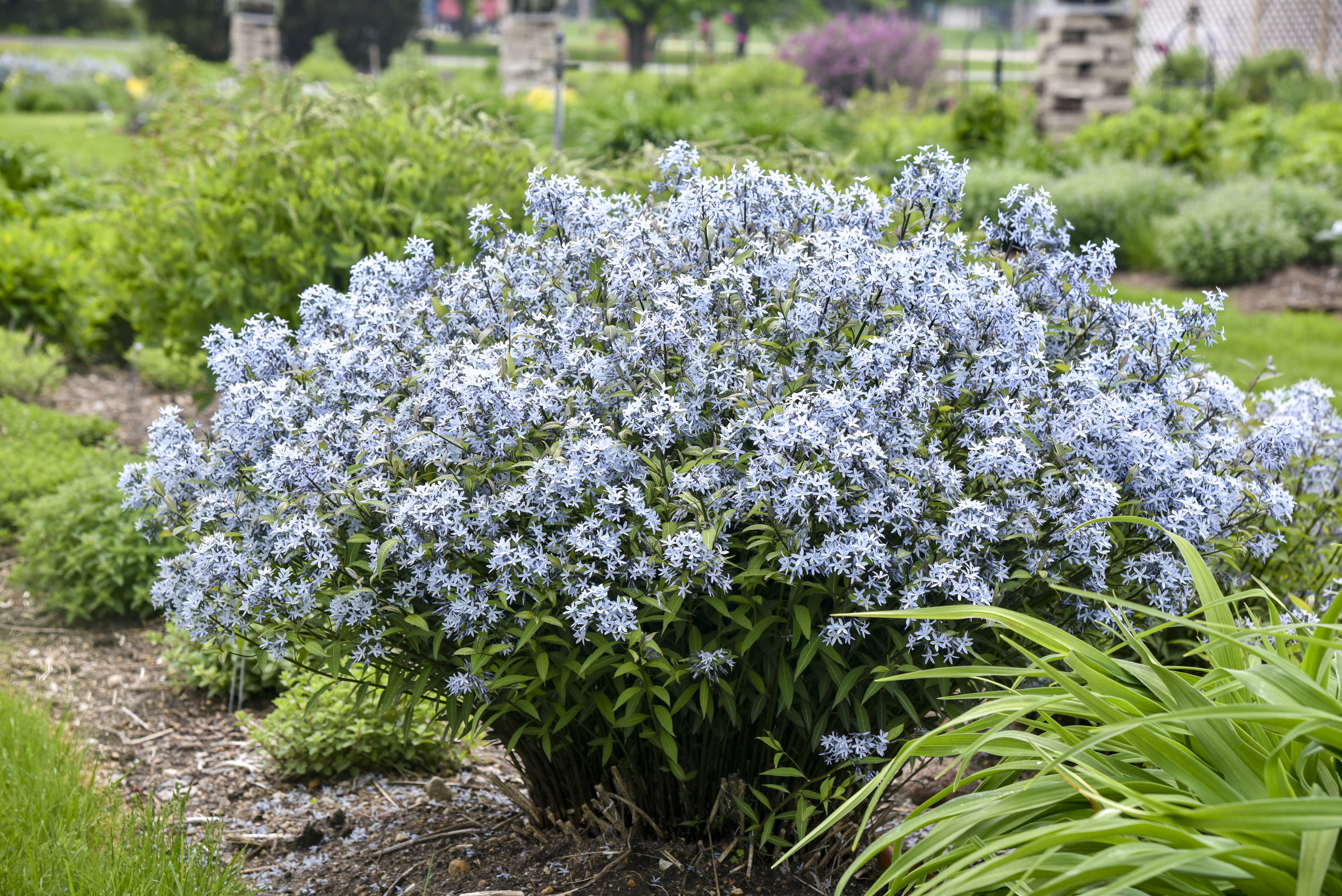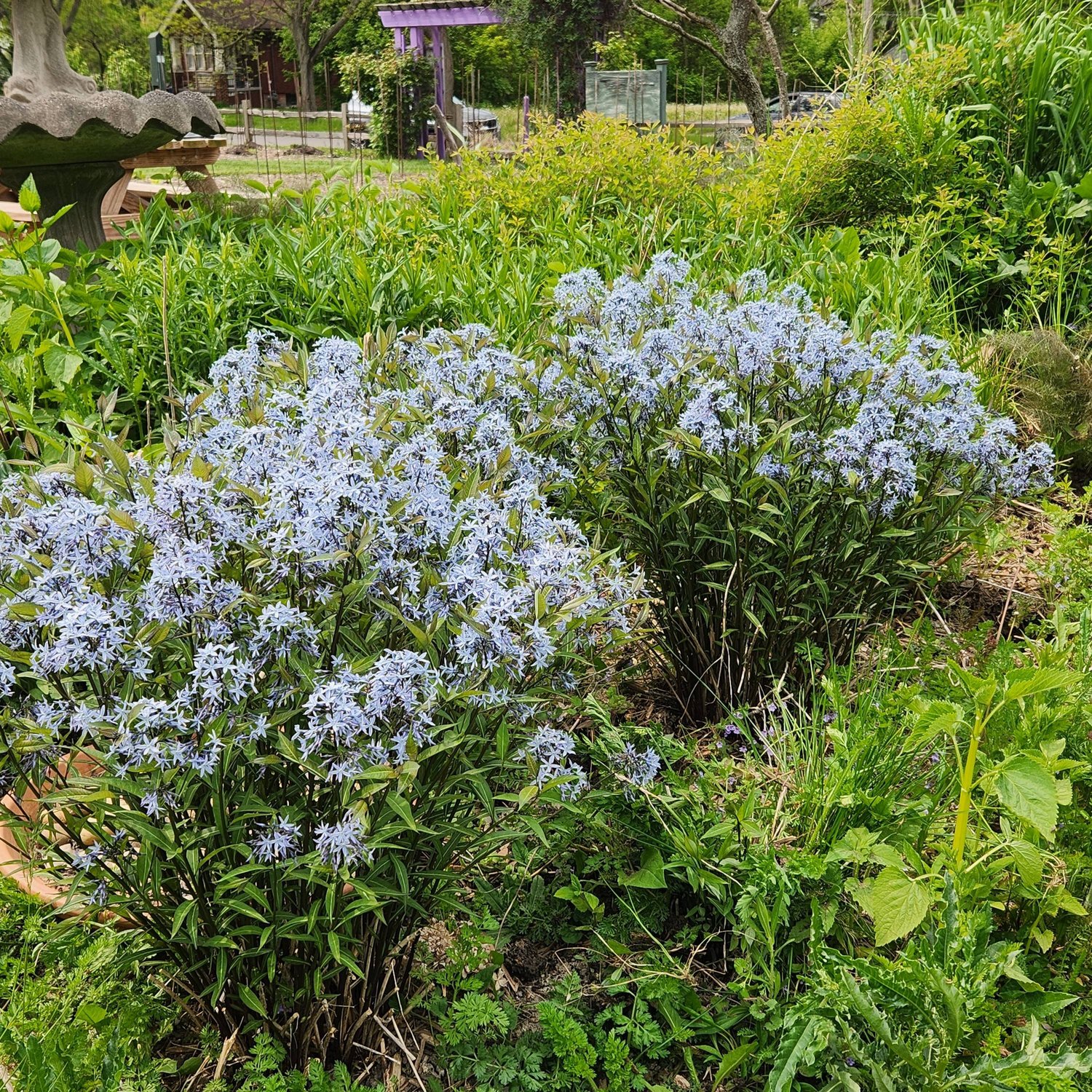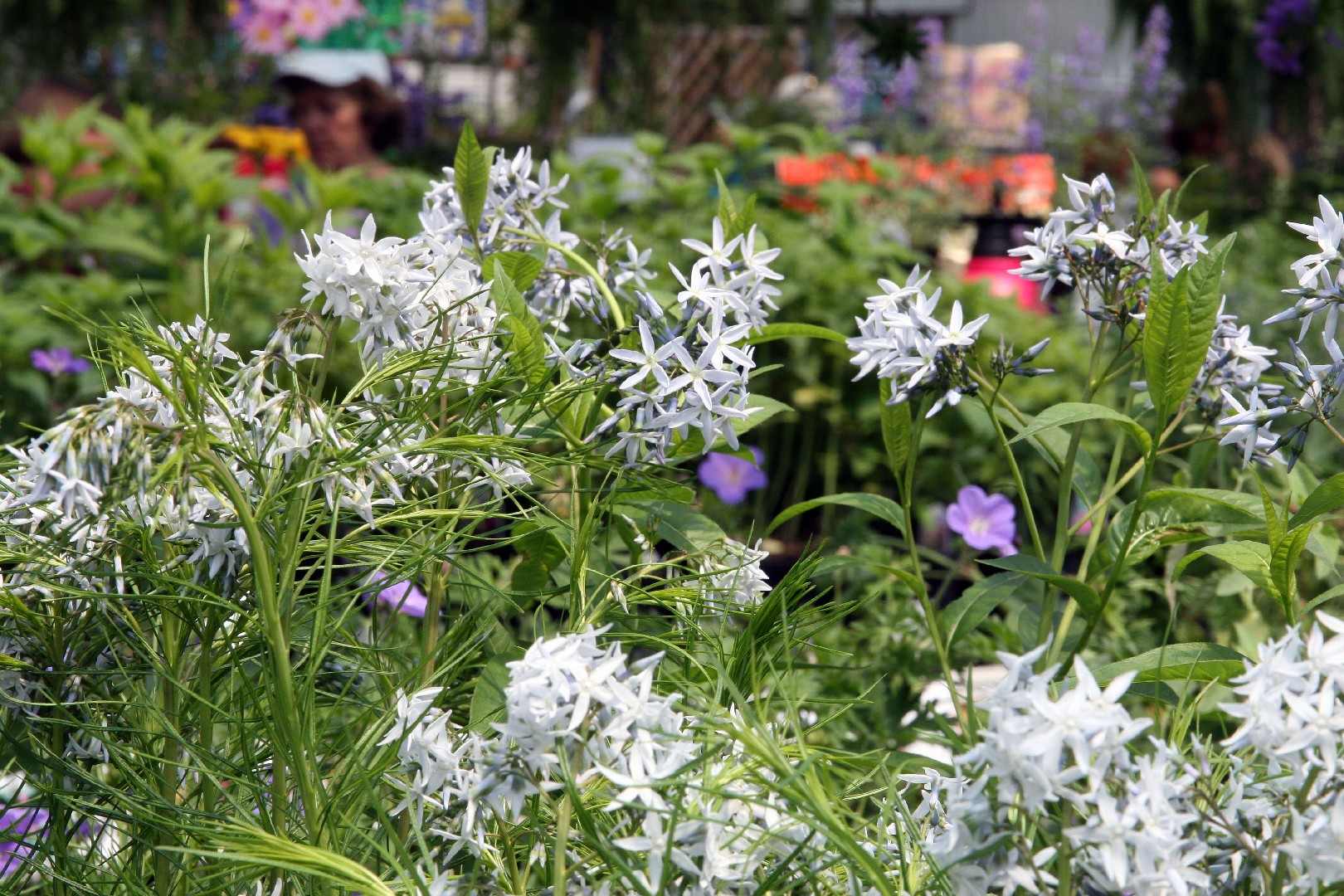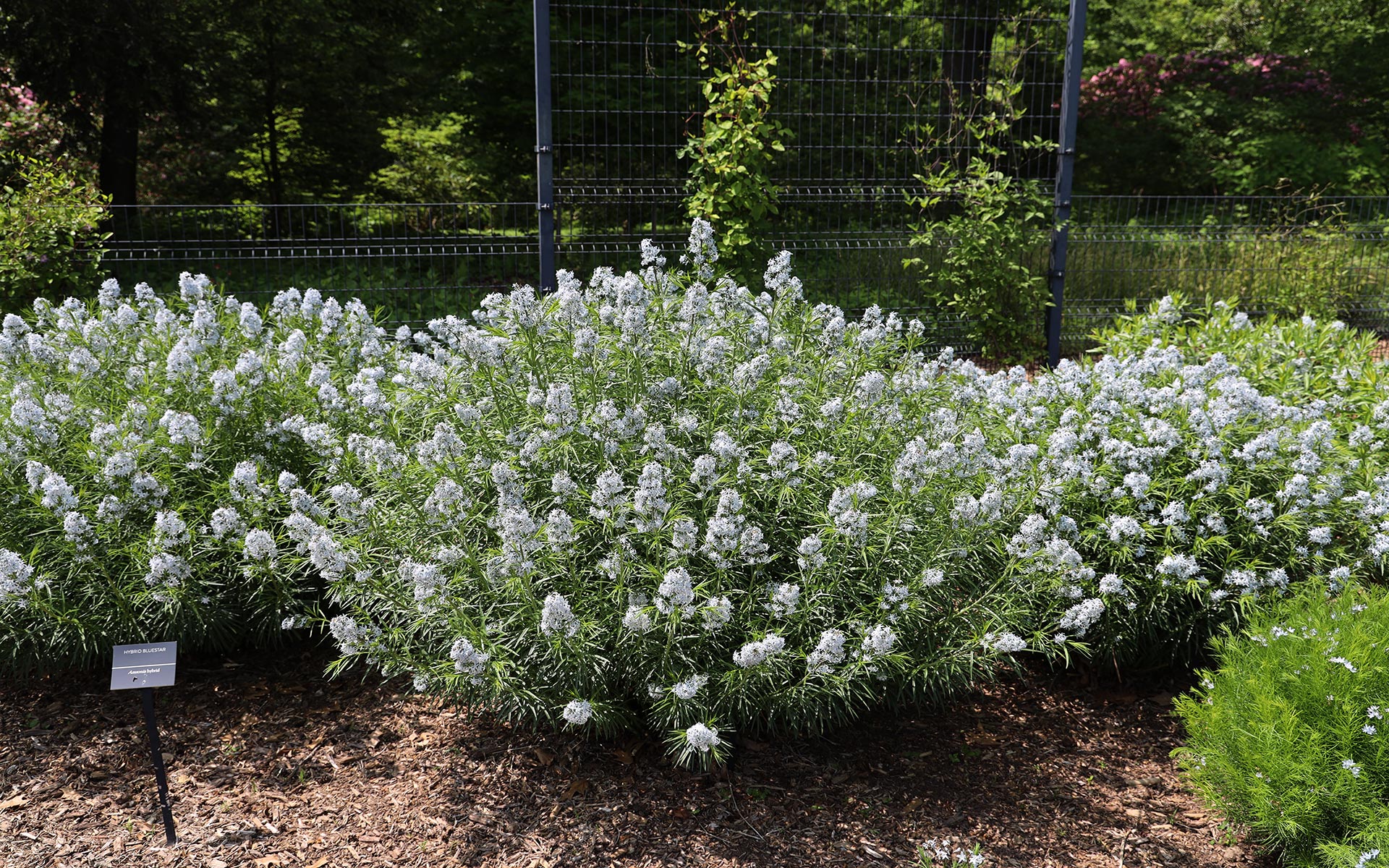Amsonia is a standout in perennial and pollinator gardens, as well as in any space needing a touch of elegance. This genus, which includes both native and non-native species, is renowned for its steel-blue flowers, slender olive-green leaves, and versatile nature. Plus, it’s a magnet for pollinators, drawing them back time and again.
Bluestar, as Amsonia is often called, is a small genus predominantly native to the United States, with a few species found in Mexico, Asia, and the Mediterranean. In the U.S., this perennial naturally thrives in southern, central, and eastern regions.
Come late spring, Amsonia steals the show with large clusters of periwinkle-blue flowers. Its graceful, willow-like foliage in deep olive green transforms into a striking golden yellow in fall, making it an attractive addition throughout the seasons. Even when not in bloom, Amsonia provides a lush green backdrop, perfect for highlighting summer and fall bloomers. It’s even been used as a shrub substitute due to its bushy nature.
Here are seven exquisite Amsonia varieties you should consider adding to your garden:
Storm Cloud
A. tabernaemontana, or Eastern bluestar, is one of the most popular and ornamental varieties in the genus. ‘Storm Cloud’ is an exceptional find among native species, boasting loose clusters of periwinkle-blue flowers in late spring. Each tubular floret, about ¾ inch wide, flares into a pointed star shape.

In spring, as temperatures rise, new stems emerge nearly black, maintaining their dark hue through the flowering period before lightening in summer. The dense, willow-shaped leaves wrap tightly around smooth stems, transitioning from dark olive green with silver veins in spring to lighter green and yellow, before finally turning golden in fall’s cooler weather.
Discovered by Hans Hansen and Tony Avent among an Amsonia colony in Bibb County, Alabama, ‘Storm Cloud’ has been trialed in Michigan and North Carolina and is celebrated for its robust growth, compact form, and prolific blooms.

Hubricht’s Narrow Leaf
A. hubrichtii, commonly known as Arkansas bluestar, is a popular variety with its delicate, thread-like foliage growing on upright stems. It has the narrowest leaves in the genus, which has earned it a reputation as one of the most cultivated species.

In 2011, A. hubrichtii was named Perennial Plant of the Year by the Perennial Plant Association, thanks to its adaptability, low maintenance needs, multiseason appeal, and resistance to pests and diseases.
This slow-growing plant forms a clump up to six feet wide. In April and May, it produces airy clouds of steel-blue flowers. By fall, its foliage turns a brilliant golden orange, adding a feathery burst of color to the garden.
The species was discovered by naturalist Leslie Hubricht in the Ouachita Mountains of Arkansas in 1942, where it thrives in fields, rocky outcrops, and along creek banks.

Blue Ice
A. orientalis ‘Blue Ice’ is a variety native to Turkey, Greece, Japan, and North America, known for its compact form and abundant flower clusters. Its dark blue buds appear in early spring, opening to reveal deep lavender-purple stars.
Among the showiest in bloom, the origin of ‘Blue Ice’ is somewhat unclear. It was discovered by nurseryman Michael Dodge at White Flower Farm in Connecticut, where it was growing among A. tabernaemontana. Its features, however, more closely resemble A. orientalis.
The flower clusters on ‘Blue Ice’ are larger than those of the species, spreading up to two feet wide.
String Theory
‘String Theory’ is a more compact version of A. hubrichtii, flowering later than ‘Storm Cloud’ in late spring and early summer. This variety spreads less, with a maximum width of 32-36 inches.

Its signature feathery leaves remain fresh and green throughout the growing season, avoiding early yellowing. In fall, the foliage turns the classic deep gold that Amsonia varieties are known for.

Short Stack
‘Short Stack’ is a dwarf version of the bluestar, producing sky-blue flowers in early April. Introduced by Plant Delights Nursery in 2003, this variety is believed to be a selection of A. tabernaemontana, though it features slightly smaller leaves and flowers.
With its low-growing, rounded form, ‘Short Stack’ requires no pruning to maintain its dense habit. The plant typically reaches 18 inches wide and 12 inches tall, making it ideal for smaller spaces.

Starstruck
‘Starstruck’ is a compact hybrid variety of Amsonia with a full, rounded habit. It reaches about three feet wide and two feet tall, blooming slightly later in the season than ‘Storm Cloud’. Its foliage and overall size are also smaller, standing nearly a foot shorter.
The dense, mounded foliage starts as dark olive green, lightening in the summer and developing chartreuse veins. In the fall, the leaves turn a striking golden color, maintaining the plant’s appeal through the cooler months.
Each of these Amsonia varieties brings its own charm and beauty to the garden, offering a blend of delicate flowers and vibrant foliage throughout the seasons. Whether you’re looking for a compact, low-maintenance option or a show-stopping perennial, Amsonia has something for every garden style.

Fringed Amsonia
Fringed Amsonia is a unique variety distinguished by the tiny hairs, or “fringe,” that appear on its new leaves and stems. It closely resembles A. hubrichtii in both leaf structure and flower form. However, the fringed variety is generally a bit larger and coarser compared to the narrow-leaf species.
This plant forms an upright clump, typically spreading about three feet wide. However, under optimal growing conditions, it has been known to reach up to an impressive seven feet in width, as observed at the Mt. Cuba Center.

Fringed Amsonia is a fine-leaved species that naturally thrives in sandy soils in the southeastern and central United States. It is adaptable to a variety of soil types but may show signs of chlorosis (yellowing of leaves) in soils with a high pH, particularly those around 7.5. Despite this, it remains a resilient and eye-catching addition to the garden, with its soft fringe adding a subtle, tactile element to the foliage.
